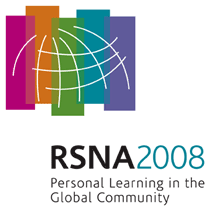
Abstract Archives of the RSNA, 2008
SSJ02-01
Invasive Lobular Carcinoma: Detection with Mammography, Ultrasound, Magnetic Resonance Imaging, and Breast-specific Gamma Imaging (BSGI)
Scientific Papers
Presented on December 2, 2008
Presented as part of SSJ02: Breast Imaging (Multiple Modalities)
Rachel Frydman Brem MD, Abstract Co-Author: Board of Directors, iCAD, Inc
Consultant, iCAD, Inc
Stockholder, iCAD, Inc
Stock options, iCAD, Inc
Board Member, Dilon Technologies LLC
Consultant, Orbotech Ltd
Marina Ioffe MD, Abstract Co-Author: Consultant, Dilon Technologies LLC
Jocelyn A Rapeyea MD, Presenter: Nothing to Disclose
Jean M. Weigert MD, Abstract Co-Author: Research grant, Dilon Technologies LLC
Margaret Lins Bertrand MD, Abstract Co-Author: Speakers Bureau, Dilon Technologies LLC
Speaker, C. R. Bard, Inc
Lillian Hirsch Stern MD, Abstract Co-Author: Speakers Bureau, Dilon Technologies LLC
To compare the sensitivity of mammography, ultrasound, magnetic resonance imaging, and breast-specific gamma imaging in the detection of invasive lobular carcinoma.
This is a retrospective multi-center study of women with biopsy-proven pure ILC. Patients had imaging with mammography and BSGI. US and MRI results, if performed, and pathologic tumor size were included. Each study was classified as positive or negative by experienced breast imagers. The sensitivity of mammography, US, MRI, and BSGI was determined for each modality and compared
Twenty six women ages 46 to 82 (mean age 62.8) with 28 biopsy proven pure ILC, mean size of 22.3mm (2mm-90mm) were included. Mammograms were negative in 6/28 (21%) cancers. Abnormal mammographic findings, 22/28 in total, included 13 asymmetric densities, 4 architectural distortions, and 5 spiculated masses. Mammography had a sensitivity of 79%. In the 25 patients who underwent US, 17 focal hypoechoic areas were detected. Sensitivity of US was 68%. Twelve patients had MRI with 10/12 lesions showing enhancement. Sensitivity of MRI was 83%. BSGI demonstrated increased uptake in 26/28 cases with a sensitivity of 93%.
BSGI has the greatest sensitivity for the detection of ILC with a sensitivity of 93% while mammography, US, and MRI demonstrated sensitivities of 79%, 68% and 83%, respectively. With its high sensitivity for detecting ILC, BSGI is an effective modality that should be used to evaluate patients with suspected cancer and has a promising role in the diagnosis of ILC.
BSGI is a highly sensitive imaging modality for the diagnois of invasive lobular carcinoma.
Brem, R,
Ioffe, M,
Rapeyea, J,
Weigert, J,
Bertrand, M,
Stern, L,
Invasive Lobular Carcinoma: Detection with Mammography, Ultrasound, Magnetic Resonance Imaging, and Breast-specific Gamma Imaging (BSGI). Radiological Society of North America 2008 Scientific Assembly and Annual Meeting, February 18 - February 20, 2008 ,Chicago IL.
http://archive.rsna.org/2008/6014637.html

